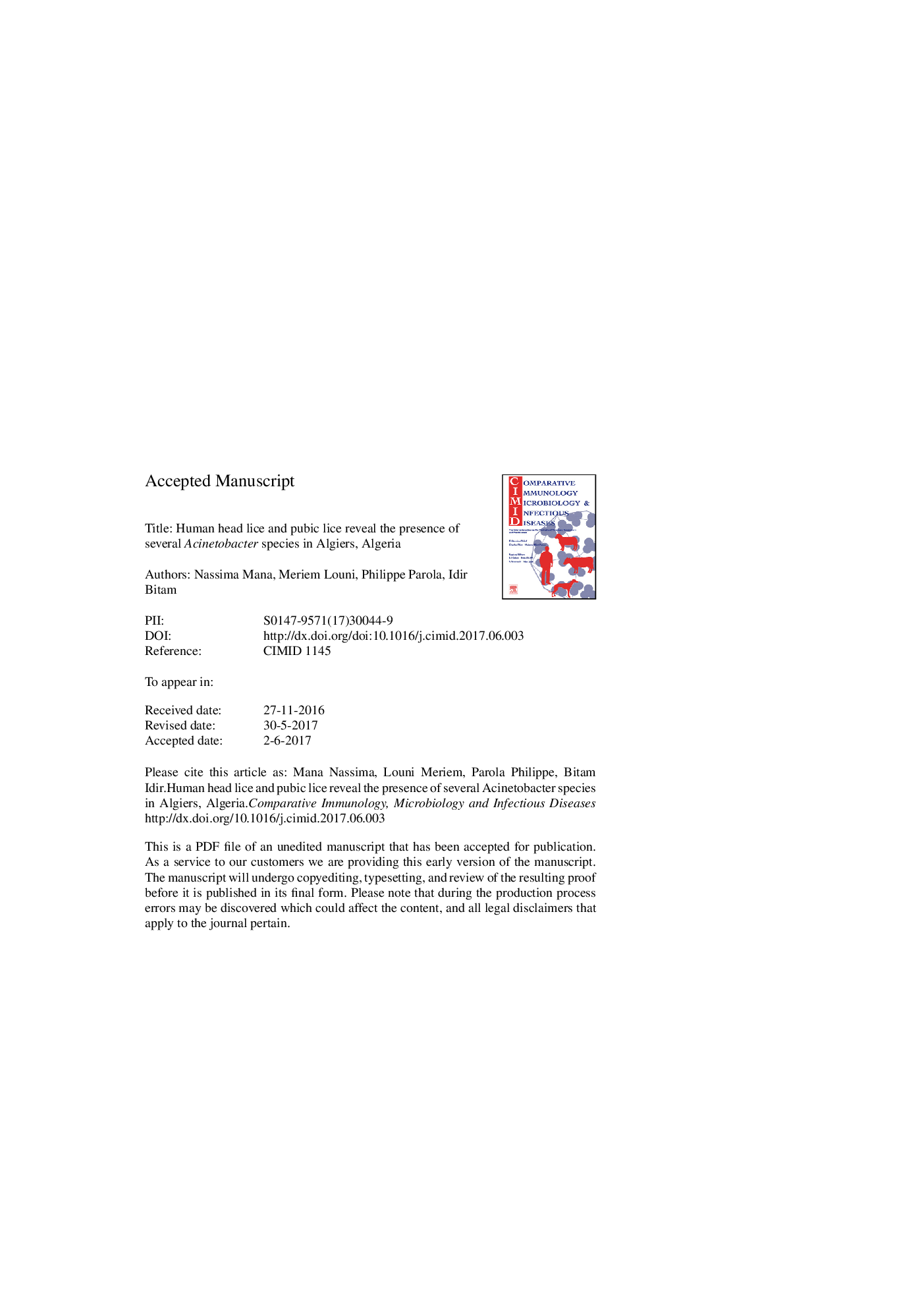| کد مقاله | کد نشریه | سال انتشار | مقاله انگلیسی | نسخه تمام متن |
|---|---|---|---|---|
| 5539892 | 1553512 | 2017 | 28 صفحه PDF | دانلود رایگان |
عنوان انگلیسی مقاله ISI
Human head lice and pubic lice reveal the presence of several Acinetobacter species in Algiers, Algeria
دانلود مقاله + سفارش ترجمه
دانلود مقاله ISI انگلیسی
رایگان برای ایرانیان
کلمات کلیدی
موضوعات مرتبط
علوم زیستی و بیوفناوری
علوم کشاورزی و بیولوژیک
علوم دامی و جانورشناسی
پیش نمایش صفحه اول مقاله

چکیده انگلیسی
There are two majorspecies of medically important lice that parasitize humans: Phthirus pubis, found in pubic hair, and Pediculus humanus. Pediculus humanus consists of two eco types that live in specific niches on the human host: body lice (Pediculus humanus humanus), found on the human body and clothing, and head lice (Pediculus humanus capitis), found on the scalp. To date, only body lice are known to be vectors of human disease; however, it has recently been reported that the DNA of several bacterial agents has been detected in head lice, raising questions about their role in the transmission of pathogens. This issue caught our attention, in addition to the fact that the pathogenic bacteria associated with P. pubis and P. humanus capitis have never been investigated in Algeria. To investigate this,molecular techniques (real-time PCR) were used to screen for the presence of Acinetobacter spp., Bartonella spp., Borrelia spp. and Rickettsia prowazekii DNA from P. humanus capitis (64 lice) collected from schoolchildren,and P. pubis (4 lice),collected from one adultman living in Algiers. Positive samples for Acinetobacter spp.were identified by sequencing therpoBgene. Conventional PCR targeting the partial Cytb gene was used to determine the phylogenetic clade of the collected lice. Of the 64 samples collected, Acinetobacter spp. DNA was detected in 17/64 (27%) of head lice, identified as: A. baumannii (14%), A. johnsonii (11%) and A. variabilis (2%). Of the four P. pubissamples, 2(50%) were positive for A. johnsonii. The phylogenetic tree based on the Cytb gene revealed that P. humanus capitis were grouped into clades A and B. In this study, we report andidentify for the first time Acinetobacter spp.in Algerian P. pubis and P. humanus capitis. The detection of the genus Acinetobacter in lice should not be underestimated, especially in P. humanus capitis, which is distributed worldwide. However, additional epidemiological data are required to determine if human lice may act as an environmental reservoir and are actively involved in the propagation of these bacteria to humans.
ناشر
Database: Elsevier - ScienceDirect (ساینس دایرکت)
Journal: Comparative Immunology, Microbiology and Infectious Diseases - Volume 53, August 2017, Pages 33-39
Journal: Comparative Immunology, Microbiology and Infectious Diseases - Volume 53, August 2017, Pages 33-39
نویسندگان
Nassima Mana, Meriem Louni, Philippe Parola, Idir Bitam,